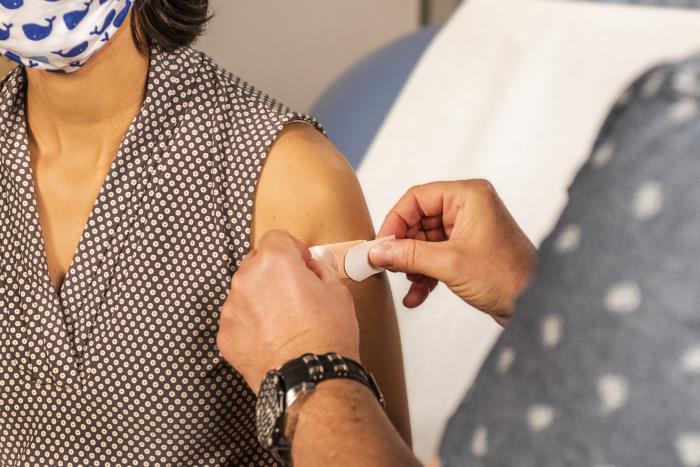As vaccinations start to slow, local county health departments are beginning “hand-to-hand combat” to reach herd immunity.
The gap is closing between the percentage of people who have started their vaccine series and those who are fully vaccinated. This means fewer people are starting their vaccine series.
“We really thought demand would be like a bell curve, and it felt like a light switch to us,” said Tess Ellens, the COVID-19 vaccine deputy for Public Health Madison and Dane County.
Wisconsin opened up vaccine eligibility to everyone 16 and older on April 5. That week, vaccinations peaked at more than 424,000 doses after seven consecutive weeks of weekly vaccination records. The next week, doses administered fell to roughly 352,000; the next was about 297,000 doses. Last week, the Department of Health Services’ early data shows just over 224,000 doses, putting the state at 34.5 percent who are fully vaccinated.
From the data DHS provides on its vaccination webpage, the groups that lead the vaccination are those 65 and older at 75.4 percent fully vaccinated and white residents at nearly 33 percent.
Mass vaccination sites work well for people who are eager to get the vaccine, Ellens said. But now, the state is in the middle group of people who had a “wait and see” approach.
The groups that lag are those ages 16-17, who are only eligible for the Pfizer vaccine as of April 5, at 10.4 percent fully vaccinated, Black Wisconsinites at 14.4 percent, and Hispanics at about 18 percent .
In a press briefing Tuesday, Gov. Tony Evers said it’s not necessarily an “anti-vax” ideology holding people back, but often it’s the workday that hinders people from getting a COVID-19 shot.
He said the state is encouraging businesses to hold vaccination clinics. He also said while vaccinations slow, the state will make it easier for people to get the shot.
“You won’t see any big sites after a while. It will be hand-to-hand combat with small clinics popping up in different places,” Evers said. “At the end of the day, we need to get shots in arms. We’ve got a good supply now. That’s not the issue. It’s getting to the people as close to home as possible with as little trouble as possible.”
Clark County is one of two sparsely populated areas in north-central Wisconsin with the lowest COVID-19 vaccination rates in the state. About 19.4 percent of its population is fully vaccinated.
“We realize there is hesitancy by some people to get vaccinated, which may be due to several factors, to include: socioeconomic status, religious or political views, access to health care, among others,” explained Kelsey Wussow, interim director of the Clark County Health Department.
The county is working to identify “gap areas,” such as people with barriers to getting a shot. This includes people who can’t leave their home, can’t take off work, need parental consent or don’t speak English. The county is also home to Mennonite and Amish communities. The health department historically sees little interest in the flu shot each year from that population.
“We continue to share information and education materials broadly to inform people about other opportunities for vaccination and keep a very robust website presence, specific to COVID-19 vaccine and other resources,” Wussow said.
The department uses media releases, email and social media to help promote vaccination efforts. For the Amish and Mennonite communities that do not have internet, the department uses snail mail to reach out. It also translates its materials into Spanish to reach the Hispanic community. Latinos make up roughly 5 percent of Clark County’s population, working predominantly in dairy and food production.
“Eventually, we may reach a point when most or all Clark County residents who want the vaccine will have had the opportunity to receive it,” she said. “We will continue outreach and education efforts to encourage residents to make informed decisions about reasons to be vaccinated against COVID-19.”
Dane County is tackling this hesitancy and slowdown in demand in three ways: mobile clinics in places such as grocery stores, education and integrating vaccines into regular public health programs such as in clinics.
“We’re wanting to make sure that we’re connecting to groups that work with kids, groups that work with parents, groups that work with the Black or Latinx community — all the different types of communities that we have within here in Dane County that we recognize might have some specific concerns related to their experiences,” Ellens said.
Dane County leads the southern half of Wisconsin for getting its population fully vaccinated — 45.1 percent.
Ellens attributes Dane County’s vaccination success thus far to its collaborations with community groups and the health care system. Rather than competing for the same resources, the county is working in tandem with other vaccinators.
But even Dane County’s coverage rates are slowing, Ellens said.
“While they’re great numbers, we recognize that … this last leg of the vaccination response will likely be the hardest because it’s thinking creatively, getting to people in different ways,” she said.
The federally run mass vaccination site at the Wisconsin Center in Milwaukee County is closing May 28. Milwaukee Mayor Tom Barrett said the city’s new approach is getting vaccinations into neighborhoods. This includes vaccination clinics at churches, the Consulate of Mexico in Milwaukee and Voces de la Frontera, for example.
“We’re taking the vaccines to the people, and we’re doing that because we know that it’s important for us to reach people where they are,” Barrett said in a health briefing Thursday.
This includes NBA games. The Milwaukee Bucks and Milwaukee Health Department hosted a mobile vaccination clinic at Fiserv Forum for Sunday’s game. Any fan attending the game was eligible to get a first dose of the Pfizer vaccine.
The state is switching up its vaccine distribution strategy, according to Evers.
“What we do need to do now, and we’ve already started it, is reach out to historically hesitant communities,” Evers told “UpFront,” produced in partnership with WisPolitics.com. “It is going to take some different strategies, frankly a lot of smaller efforts, all across the state,” he said.
See the Wisconsin COVID-19 Timeline: https://www.wispolitics.com/wisconsin-coronavirus-resources/
For more of the most relevant news on the coronavirus outbreak, reports on groundbreaking health research in Wisconsin and links to top stories, sign up today for the free daily Health Care Report from WisPolitics.com and WisBusiness.com.
Sign up here: https://forms.gle/o8FtqTLviGJPja8C9
-By Stephanie Hoff
WisBusiness.com






